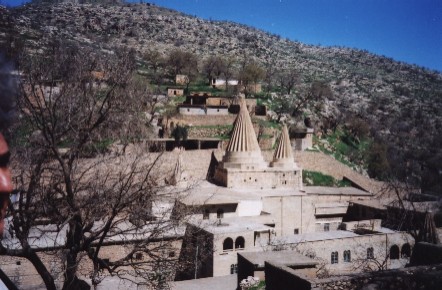
Then said the Mighty Lord, "O Angels, I will create Adam and Eve, and will make them human beings, and from them two shall arise, out of the loins of Adam, Shehr ibn Jebr; and from him shall arise a single people on the earth, the people of 'Azazel, to wit of Ta'us Melek, which is the Yezidi people. Then I shall send Sheikh 'Adi b. Musafir from the land of Syria, and he shall come and dwell in Lalesh".Meshaf Resh: The Black Book
Lucifer as the rebel angel is the historical underpining meme of heresy in all the Abrahamic based religions. Today we will look at the Yezedi, who it is claimed are most ancient of the pre-Judeaic, pre-Christian, cults dedicated to the worship of Lucifer. Originally they were an Aryan fire religion, not unlike Zororastrianism with which they share a common belief in duality. In order to survive the advent of the Abrahamic religions domination of the region they became a syncretic religion when their religious tenants were revised under the influence of Sheik Adi.
The Yezidi worship Malak Tawus, or "Peacock Angel," aka Lucifer. However, Lucifer is viewed differently from the Christian Lucifer, or devil. Yezidis see him as the chief archangel and creator of the material world. The Yezidi religion is centered in the village of Lalish in northern Iraq's Ninawah Province.
Towers of Lalish
Lalish: the Kurds´ hidden treasure in northern IraqSafe in the Kurdish haven of northern Iraq, but still only 50 km north of war-torn Mosul, lies Lalish, the Yezidi Kurds´ holiest shrine. Visiting this particular site, tantamount to the Catholics´ Vatican or Muslims’ Mecca, had become an obsession since I first came across Yezidi Kurds back in the summer of 2004. I met them in their Yailas (summer encampments) on the slopes of Mt. Aragats, Armenia’s highest peak, which consisted of a handful of green Soviet Army tents, one for each family, where they spend the summer with their cattle. Despite the temperature climbing above 40 celsius down in Yerevan, the animals were grazing Armenia's freshest pastures between snow patches; a remarkable example of the so called "Vertical Nomadism". Like most Armenian Kurds, these shepherds were Yezidi too, descendants of those who had left the hilly north of Iraq several centuries ago escaping from the Arabs’ oppression. They shared their cheese and their knowledge about their religion with me, and it was they who first pointed me in the direction of Lalish.
Yezidi couple
Summer of 2005 in Northern Iraq wasn't as cool nor as peaceful as on Mount Aragats. Crossing the border from Turkey at Silopi had taken me a whole day filling out various documents, queuing under the sun and answering lots of questions on the Kurdish side. Anyhow, the city of Dohuk was the perfect place to stay for a few days to get familiarized with the local customs, and moreover, to arrange a visit to the shrine at the Lalish Centre, the meeting point of yezidies in Dohuk.
The Yezedi whose name is spelled variously; Yazedi, Isadi, Yezidi, Yazidi (by Wikipedia) represent a link to ancient Aryan cults from Persia, Assyria and also a link to the pre Abrahamic religions in the region; both Mandeanism and Manichaeism.
In the case of Mandeanism they have been mistakenly associated with the Sabean-Mandean cult which also exists in Iraq today.
